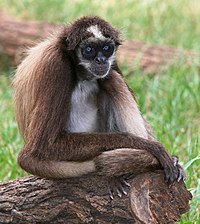Portal:Primates
The Primates Portal A primate is a member of the biological order Primates, the group that contains lemurs, the aye-aye, lorisids, galagos, tarsiers, monkeys, and apes, with the last category including great apes. With the exception of humans, who inhabit every continent on Earth, most primates live in tropical or subtropical regions of the Americas, Africa and Asia. Primates range in size from the 30-gram (1 oz) pygmy mouse lemur to the 200-kilogram (440 lb) mountain gorilla. According to fossil evidence, the primitive ancestors of primates may have existed in the late Cretaceous period around 65 mya (million years ago), and the oldest known primate is the Late Paleocene Plesiadapis, c. 55–58 mya. Molecular clock studies suggest that the primate branch may be even older, originating in the mid-Cretaceous period around 85 mya. Primates exhibit a wide range of characteristics. Some primates do not live primarily in trees, but all species possess adaptations for climbing trees. Locomotion techniques used include leaping from tree to tree, walking on two or four limbs, knuckle-walking, and swinging between branches of trees (known as brachiation). Primates are characterized by their large brains relative to other mammals. These features are most significant in monkeys and apes, and noticeably less so in lorises and lemurs. Many species are sexually dimorphic, which means males and females have different physical traits, including body mass, canine tooth size, and coloration.
Selected article
Saadanius is a genus of fossil primate dating to the Oligocene that is closely related to the common ancestor of the Old World monkeys and apes, collectively known as catarrhines. It is represented by a single species, Saadanius hijazensis, which is known only from a single partial skull tentatively dated between 29 and 28 mya (million years ago). It was discovered in 2009 in western Saudi Arabia near Mecca and was first described in 2010 after a comparison with both living and fossil catarrhines. Saadanius had a longer face than living catarrhines and lacked the advanced frontal sinus (airspaces in the facial bones) found in living catarrhines. However, it had a bony ear tube (ectotympanic) and teeth comparable to those of living catarrhines. The discovery of Saadanius may help answer questions about the appearance of the last common ancestors of Old World monkeys and apes and help date the evolutionary split between these two primate groups.
Selected picture The brown spider monkey, Ateles hybridus, is a species of spider monkey, a type of New World monkey, from South America. It is found in Colombia and Venezuela. Like all spider monkeys, it has very long, spindly limbs and a lengthy prehensile tail which can almost be called a fifth limb. The tail is made up of highly flexible, hairless tips with skin grooves which improves grip on tree branches and is adapted to its strictly arboreal lifestyle. It is currently critically endangered, with few examples of them remaining in the wild. CategoriesSelected species Near Threatened (IUCN 3.1)|Near Threatened The ring-tailed lemur (Lemur catta) is a large strepsirhine primate and the most recognized lemur due to its long, black and white ringed tail. Like all lemurs it is endemic to the island of Madagascar. It is omnivorous and the most terrestrial of lemurs. The animal is diurnal, being active exclusively in daylight hours. The ring-tailed lemur is highly social, living in groups of up to 30 individuals. As one of the most vocal primates, the ring-tailed lemur utilizes numerous vocalizations including group cohesion and alarm calls. Despite being listed as Near Threatened by the IUCN Red List and suffering from habitat destruction, the ring-tailed lemur reproduces readily in captivity and is the most populous lemur in zoos worldwide, numbering more than 2000 individuals. It typically lives 16 to 19 years in the wild and 27 years in captivity. Did you know?
Primate lists
WikiProjectsThings to do
Associated WikimediaDiscover Wikipedia using portals |

















